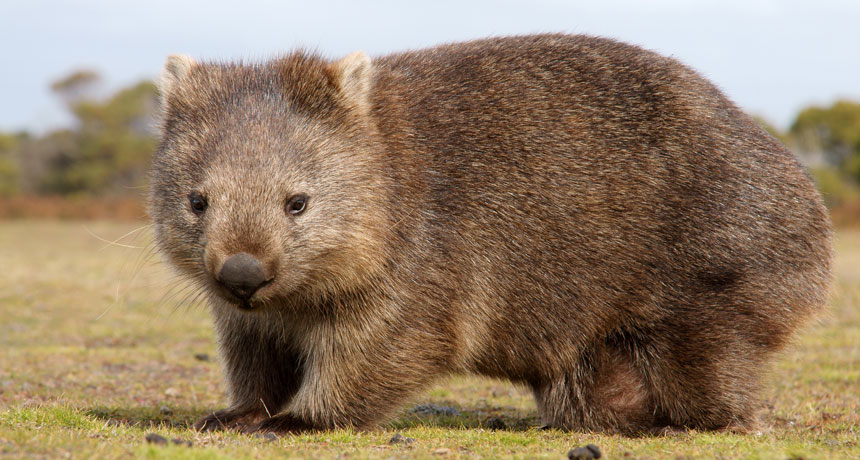Wombats are the only animals whose poop is a cube. Here’s how they do it.
The elasticity of wombats’ intestines helps to shape their distinctive poops

THE SCOOP An in-depth look at the physics of wombat poop is among 10 stories that captivated Science News readers in 2018.
Marco Tomasini/Shutterstock
- More than 2 years ago
Of all the poops in the world, only wombats’ are shaped like cubes.
The varied elasticity of the wombat’s intestines helps the marsupials to sculpt their scat into cubelike nuggets, instead of the round pellets, messy piles or tubular coils made by other mammals, researchers reported November 18 at the American Physical Society Division of Fluid Dynamics meeting in Atlanta.
Wombats mark their territories with small piles of scat. Cuboid poops stack better than rounder ones, and don’t roll away as easily.
But cubic shapes in nature are very unusual, says mechanical engineer David Hu of Georgia Institute of Technology in Atlanta. Making and maintaining flat facets and sharp corners takes energy. So it’s surprising that the wombat’s intestines — which look much like those of any other mammal — would create that shape.
When an Australian colleague sent Hu and his colleague Patricia Yang the intestines from two roadkill wombats collecting frost in his freezer, “we opened those intestines up like it was Christmas,” Hu says.
The intestines were packed with poop, Yang says. In humans, a poop-filled bit of intestine stretches out slightly. In wombats, the intestine stretches to two to three times its regular width to accommodate all of the feces.

Yang used skinny balloons — the type that gets sculpted into animals at carnivals — to inflate the intestines and measure their stretchiness in different places. Some regions were more stretchy; some were stiffer. The stiffer regions probably help create the distinct edges on the wombat poops as the waste moves through the gut, Yang proposes.
Sculpting the poop into cuboid nuggets appears to be a finishing touch for the wombat digestive tract. Over a typical 6-meter-long wombat intestine, the poops take on distinct edges only in the last half a meter or so, Hu says. Up to that point, the waste is gradually solidifying as it moves through the gut.
The finished turds are especially dry and fibrous, which may help them retain their signature shape when they’re squeezed out, Yang suggests. They can be stacked or rolled like dice, standing up on any of their faces. (She knows. She tried it.)
In the wild, wombats deposit their droppings on top of rocks or logs as territory markers, sometimes forming small piles. They seem to prefer to poop in elevated spots, Hu says, but they’re also limited by their stubby legs.
To confirm that the elasticity variation really does form the cubes, Yang and Hu are now trying to model the wombat digestive tract using panty hose.
Editor’s note: This story was updated on November 28, 2018, to correct the description of a typical wombat’s intestine. It’s 6 meters long (not 30 meters), and the poop takes a cubelike shape in the last half a meter (not the last meter).






